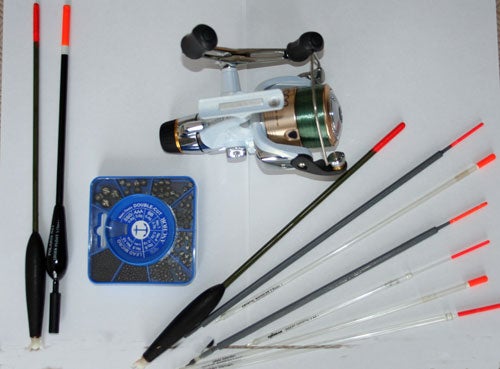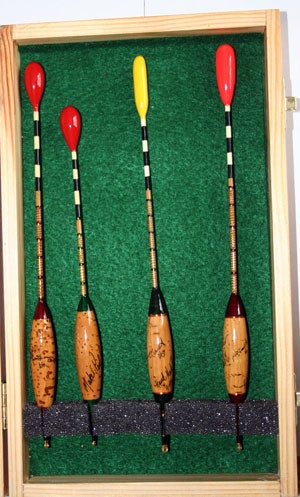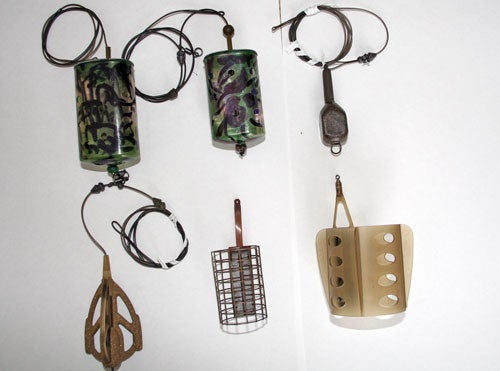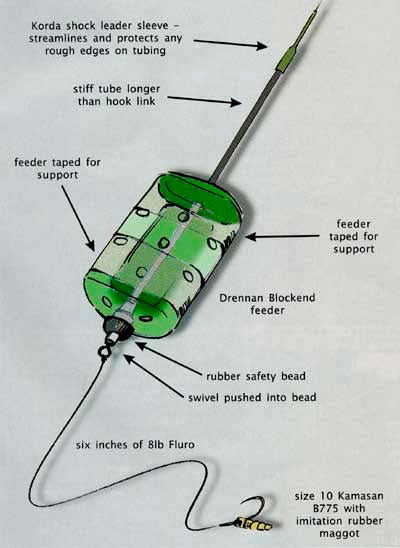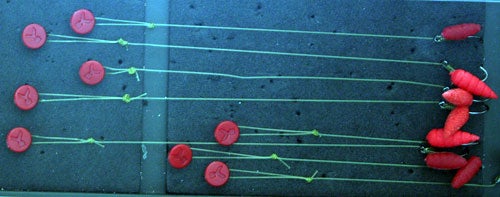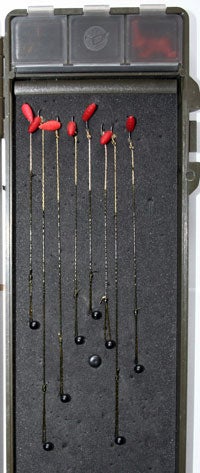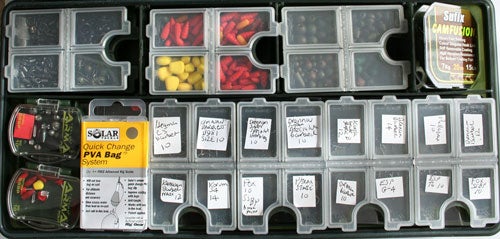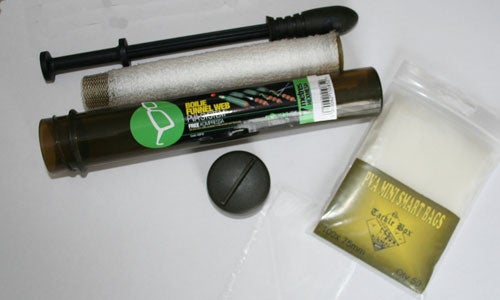| THE TENCHFISHERS | |
|
Pit Fishing for Tench – Part 2, The Tenchfisher’s Tackle BoxMaking the move from canal or estate lake to pursue the larger gravel pit specimens really does not require a lot of specialist kit. In fact you will likely have most of the gear already. In Part 2 I look at some of the terminal kit I use and open up my tackle box for inspection! Some handy tactical tips are also provided for the gravel pit newcomer.
Float Fishing Float image and trad float image Wagglers Locslide or Polaris? Reels
Feeders Pictured above, are the selection of feeders that I regularly use. The maggot inline feeders are made by converting a standard Drennan block end. A hole is bored top and bottom to accept a John Roberts feeder boom tube. If like me you intend using a TFG or Korda sinking leader check tube diameter is sufficient to allow feeder to pull off looped end and “be safe”. (For components see the photo in Part 1.) A tulip bead keeps the tube in place at the bottom of the feeder and you should leave top of tube unsecured if you are using a leader. Illustration shows a rig where no leader is employed , the feeder is running directly on mainline.
These inline feeders are the classic ” bolt set up” where the heavy feeder weight acts as a standard lead would in carp fishing. They can be used with a standard hooklink or a helicopter set up. These rigs with short semi stiff links can be devastatingly effective hookers but they are not the only solution to catching tench! PVA Bag Rig. The components for this are a Korda SafeZone helicopter rigged leader to which is attached a Solar PVA bag rig. You will need to remove the plastic core of the inline lead. Solar provide an excellent leaflet to show you how to build this rig. The PVA Korda Micromesh is filled with red maggots and hooked onto the bag clip which is then pushed back inside the lead’s internal bore to secure. My favourite lead is a Korda Inline Square Pear. I fish this heli’ style with a 6″ Amnesia semi stiff link , knotless knotted to a Size 10 Owner C5. This is nicked into the bag before casting. This is a superb rig for weedy venues. If you put a standard feeder on all you are doing is making a weed anchor! Tip: Make sure you dry lead and clip thoroughly before attaching the PVA stocking or you will end up with a headful of maggots when you cast! Method Feeder Much overlooked as it is presumed you need a 3lb TC rod to cast one! Well if you buy a Mini Fox Feeder (about 14g) oraA Korda/Drennan 27g you can use them with 1.75TC rods. Just remember not to overload them. I just filll up to the cage rim and do not produce a lemon sized ball! I use scalded pellets as the inner core. The outer is a mixture of CC Moore Stick Mix and the excellent Dynamite Tinned Meaty Marine Groundbait. Prepare to stink for days! I prefer short inline hooklinks with Method feeders. Cage Feeder Simple and tried and tested. Quick to fill with a groundbait and particle mix. Ideal for short range and margin fishing. A traditional feeder which tends to be a bit neglected these days. Carp Groundbait Feeder These Fox feeders will deliver a large cargo of groundbait and particle. You will need to use a method groundbait mix with these to ensure the contents won’t spill out on the cast as they have a large diameter. If the tench are really having it then this is an ideal way to deliver lots of grub Hook Links Braid or Mono?
The Xcelon is matched to a Size 10 Owner C5, and once tied up with a knotless knot you can get the type of aggressive hooking angle without the need to resort to silicone shank extensions. The same goes for 15lb Amnesia, you get fantastic hook turnover with a simple knotless knot. I counterbalance the hook weight with Enterprise maggot artificials. You will need a leap of faith here as these rigs look very crude for tench and they are! But early season when bigger baits are acceptable these are the business! With Amnesia it is often easier to crimp short hook lengths rather than fiddle about tying them. A set of Wychwood crimping pliers and crimps will do that job for you. I do not bother with swivels and tie in a simple figure of eight loop for loop to loop attachment. A Finer approach If I am using smaller size 12 and 14 hooks then my choice without exception is Suffix Camfusion 10lb bs. This coated braid strips easily and has an unobtrusive finish. It lies flat (you should tank test all your rigs) and does not need steaming with very little memory. The combi rig adds confidence in that braid tangles are a thing of the past and you have a superbly reliable set up. Full marks to Gardner for a fantastic product.
A Look Inside My Tackle Box You do not need a mass of terminal tackle to go tenching. I use the excellent Korum Rig Manager (fully loaded) and a Gardner Rig Roll. Both are very compact compared to a large Fox Box. Because space is limited it discourages taking excess kit and takes up little room in the ruckbag.
A varied hook selection that include my favourite : Owner C5, Drennan Barbel, Drennan Super Specialist, Kamasan B981, Korum S4, Fox Series 2B, Pallatrax, ESP T6/G4, Fox SSBP. Drennan Specialists are not really suitable for knotless knots or coated braids as the eye diameters are too small. I use these with a very fine Fox uncoated braid like Megasilk using a whipping knot. Majority of the terminal kit is Korda. Two rig boards hold all my mono and combi hook rigs all set up with artificial Enterprise maggot(s) to give a neutral buoyancy. On the lower level is the excellent Solar Quick Change PVA bag system. PVA, Flexibility In A Tube! If its weedy then I think it’s time to abandon the feeder (or weed anchor!) and set up a PVA rig.
You have the choice of bags or the mesh type on a tube. I do prefer the mesh tube as it is less fiddly to set up and you do not get the problem of trapped air causing the rig to float. For maggots the Korda Micromesh is brilliant albeit the PVA is not inexpensive! But it does give you the opportunity to present a cargo of bait over weed. The famous Korda Stick which comprises a compressed groundbait mix is a great addition to any set up. It also allows a tangle free presentation if you are using a standard braid. A tiny stick nicked on the hook is a great anti tangle device. I favour CC Moores Stick Mix and a top up of oily Dynamite Marine Tinned Groundbait. CC Moore Belachan is a great additive too. Tip; Remember any water based additives will melt the PVA so only used oil based liquids. Do not prepare these too long in advanced otherwise the PVA will get oil soaked and will not melt. In deep water you might need to double bag/mesh. PVA bags are great if you want to include the lead in the package. The Tackle Box bags are great value and superb quality. Probably the best method if you are fishing in very heavy weed. Summary I hope this review will help the newcomer to gravel pit tenching. In reality the method and kit I use is all very basic, I hate complicated rigs and having to sort through tons of bits in a tackle box. These methods catch me specimen tench every season with the minimum of fuss. You have both traditional methods here and some fresher approaches that have been influenced by carping developments. I am fortunate in getting a lot of feedback from my fellow members of The Tenchfishers which speeds up any new rig developments. You will note that I have not really looked at boile rigs as I rarely use them for tench – except on Sywell which was once a noted boilie venue. A look at any Carp magazine will put you right there but do pick the simple ones, as you do not need 20 components on each rig! Enjoy your Spring Tenching! |











